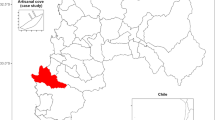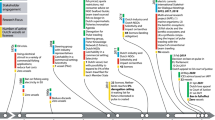Abstract
The fishery for Northeast Atlantic cod (Gadus morhua) in the Barents Sea is one of the most valuable fisheries in the North Atlantic. After the introduction of Extended Fisheries Jurisdiction, cod is a shared stock between Norway and Russia. Overfishing of quotas has been a concern for a number of years. The purpose of this article is to analyse cooperative and non-cooperative management of the Northeast Atlantic cod fishery. This will be done in a game theoretic context, based on different assumptions regarding important variables such as cost of effort and initial stock size. The game theoretic analysis will be based on an empirical bioeconomic model developed and estimated by Hannesson (Mar Policy 31:698–705, 2007; J Bioecon forthcoming). The case of cooperative management is analysed for different cost parameters and starting values of the stock. An interesting result is that the optimal policy gives rise to pulse fishing. As this involves effort (and harvests) varying from year to year, potentially imposing substantial social costs on the industry in years when the fishery is closed, a policy of constant effort is also considered. Finally, non-cooperative management is analysed.
Similar content being viewed by others
References
Årland K., Bjørndal T. (2002) Fisheries management in Norway. Marine Policy 26: 307–313
Armstrong C. W. (1994) Cooperative solutions in a transboundary fishery: The Russian–Norwegian co-management of the Arcto–Norwegian cod stock. Marine Resource Economics 9: 329–351
Armstrong C. W. (1998) Sharing a fish resource: Bargaining theoretical analysis of an applied allocation rule. Marine Policy 22: 119–134
Asche F., Bjørndal T., Gordon D. V. (2009) Rents in an individual quota fishery. Land Economics 85(2): 279–291
Bjørndal T., Brasao A. (2006) The Northern Atlantic bluefin tuna fisheries: Management and policy implications. Marine Resource Economics 21: 193–210
Bjørndal T., Kaitala V., Lindroos M., Munro G. R. (2000) The management of high seas fisheries. Annals of Operations Research 94: 183–196
Bjørndal T., Munro G. R. (1998) The economics of fisheries management: A survey. In: Tietenberg T., Folmer H. (eds) The international yearbook of environmental and resource economics 1998/1999. Elgar, Cheltenham
Bjørndal, T., & Munro, G. R. (2007). Shared fish stocks and high seas issues. In Handbook of operations research in natural resources. International series in operations research & management science (Vol. 99, 2). New York: Springer.
Bogstad B., Hiis Hauge K., Ulltang Ø. (1997) MULTSPEC—a multi-species model for fish and marine mammals in the Barents Sea. Journal of Northwest Atlantic Fisheries Science 22: 317–341
Clark C. W. (1980) Restricted access to common-property fishery resources: A game theoretic analysis. In: Liu P. (eds) Dynamic optimisation and mathematical economics. Plenum Press, New York, pp 117–132
Hamre J. (2003) Capelin and herring as key species for the yield of north-east Arctic cod. Results from multispecies runs. Scentia Marina 67(1): 315–323
Hannesson R. (2007) Cheating about the cod. Marine Policy 31: 698–705
Hannesson, R. (2011). Why is fish quota enforcement worth while? A study of the Northeast Arctic cod. Journal of Bioeconomics (forthcoming).
Hannesson R., Steinshamn S. I. (1991) How to set catch quotas: Constant effort or constant catch?. Journal of Environmental Economics and Management 20: 71–91
Hoel A. H. (1994) The Barents Sea: Fisheries resources for Europe and Russia. In: Stokke O. S., Tunander O. (eds) The Barents Region. Cooperation in Arctic Europe. International Peace Research Institute/Fritjof Nansen Institute, Oslo
Hønneland G. (1993) Fiskeren og allmenningen; forvaltning og kontroll: Makt og kommunikasjon I kontrollen med fisket i Barentshavet. University of Tromsø, Tromsø
Kitti M., Lindroos M., Kaitala V. (2002) Optimal harvesting of the Norwegian spring-spawning herring stock. Environmental Modeling & Assessment 7: 47–55
Korsbrekke K., Mehl S., Nakken O., Pennington M. (2001) A survey-based assessment of the Northeast Arctic cod stock. ICES Journal of Marine Science 58: 763–769
McCallum H. I. (1988) Pulse fishing may be superior to selective fishing. Mathematical Biosciences 89: 177–181
Munro G. R. (1979) The optimal management of transboundary renewable resources. Canadian Journal of Economics 12: 355–376
Munro, G. R., Van Houtte, A., & Willmann, R. (2004). The conservation and management of shared fish stocks: Legal and economic aspects. Rome: FAO Fisheries Technical Paper 465.
Nakken O. (1998) Past, present and future exploitation and management of marine resources in the Barents Sea and adjacent areas. Fisheries Research 37: 23–35
Sumaila U. R. (1997a) Strategic dynamic interaction: The case of the Barents Sea fisheries. Marine Resource Economics 12: 77–94
Sumaila U. R. (1997b) Cooperative and non-cooperative exploitation of the Arcto-Norwegian cod stock. Environmental and Resource Economics 10: 147–165
Tahvonen O. (2009) Economics of harvesting age-structured fish populations. Journal of Environmental Economics and Management 58: 281–299
Valderrama D., Anderson J. L. (2007) Improving utilisation of the Atlantic sea scallop resource: An analysis of rotational management of fishing grounds. Land Economics 83: 86–103
Author information
Authors and Affiliations
Corresponding author
Rights and permissions
About this article
Cite this article
Bjørndal, T., Lindroos, M. Cooperative and non-cooperative management of the Northeast Atlantic cod fishery. J Bioecon 14, 41–60 (2012). https://doi.org/10.1007/s10818-011-9106-0
Published:
Issue Date:
DOI: https://doi.org/10.1007/s10818-011-9106-0




